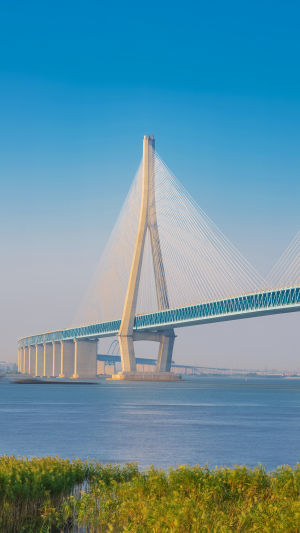Discovering the world's most renowned bridges unveils incredible feats of modern engineering.
These structures span vast distances and link bustling cities, exemplifying human creativity and technological advancement. Whether you're drawn to their architectural brilliance or fascinated by their role in global connectivity, these bridges captivate both engineering enthusiasts and curious travelers alike.
<h3>1. The Danyang–Kunshan Grand Bridge</h3>
It is a marvel of modern engineering and holds the title of the longest bridge in the world.
Spanning an impressive 164.8 kilometers (102.4 miles), this bridge is part of the Beijing-Shanghai High-Speed Railway and stretches across the Yangtze River Delta in Jiangsu province, China.
Constructed between 2006 and 2010, the Danyang–Kunshan Grand Bridge was a massive undertaking. The project involved over 10,000 workers and required around 450,000 tons of steel and 2.3 million cubic meters of concrete. The bridge officially opened in June 2011, providing a critical link in China's high-speed rail network.
<b>Design and Structure</b>
The Danyang–Kunshan Grand Bridge is an elevated viaduct, designed to withstand natural disasters such as earthquakes and typhoons. The bridge crosses lowland rice paddies, canals, rivers, and lakes, demonstrating the versatility and adaptability of modern bridge design.
<b>Key Features</b>
<b>Length:</b> At 164.8 kilometers, it is the longest bridge in the world.
<b>Construction:</b> Built over four years with significant manpower and resources.
<b>Purpose:</b> Facilitates high-speed rail travel between Beijing and Shanghai, drastically reducing travel time.
<b>Impact on Transportation</b>
<b>The Danyang–Kunshan Grand Bridge</b> plays a crucial role in China's high-speed rail network, connecting major economic regions and significantly improving travel efficiency. The high-speed rail line reduces the travel time between Beijing and Shanghai from over 10 hours to about 4.5 hours, fostering economic growth and making daily commutes more feasible for millions.
<b>Environmental and Economic Benefits</b>
The bridge's construction has had positive impacts on both the environment and the economy. By facilitating high-speed rail travel, it helps reduce the reliance on cars and airplanes, thereby lowering carbon emissions. Economically, it has boosted connectivity between major cities, promoting trade, tourism, and job creation.
The Danyang–Kunshan Grand Bridge is not just a record-holder but a testament to human ingenuity and the drive to connect distant places efficiently. Its construction has transformed travel in China, setting a benchmark for future infrastructural projects worldwide.
<h3>2. Hong Kong-Zhuhai-Macau Bridge</h3>
The Hong Kong-Zhuhai-Macau Bridge (HZMB) is another engineering marvel, connecting Hong Kong, Zhuhai, and Macau. This bridge-tunnel system spans 55 kilometers (34 miles) and is the longest sea crossing in the world.
<b>Design and Structure</b>
The HZMB consists of three cable-stayed bridges, an undersea tunnel, and four artificial islands. It was designed to withstand earthquakes, typhoons, and ship collisions. Construction began in 2009 and was completed in 2018.
<b>Key Features</b>
<b>Length:</b> 55 kilometers, including bridges and tunnels.
<b>Construction:</b> Built with innovative techniques to ensure durability and safety.
<b>Purpose:</b> Enhances connectivity between Hong Kong, Zhuhai, and Macau, reducing travel time significantly.
<b>Impact on Transportation</b>
The HZMB has drastically cut down travel time between the three cities from several hours to about 30 minutes, boosting economic ties and fostering regional integration.
<b>Environmental and Economic Benefits</b>
The bridge reduces the reliance on ferries and other slower modes of transport, leading to lower emissions. It has also spurred economic growth by facilitating trade and tourism in the region.
<h3>3. Wuhan Yangtze River Bridge</h3>
The Wuhan Yangtze River Bridge is a historical and strategic bridge in Wuhan, Hubei province, China. Completed in 1957, it was the first bridge over the Yangtze River.
<b>Design and Structure</b>
This dual-purpose bridge serves both rail and road traffic. It is 1.6 kilometers (1 mile) long and has two levels: the upper deck for vehicles and the lower deck for trains.
<b>Key Features</b>
<b>Length:</b> 1.6 kilometers, accommodating both rail and road traffic.
<b>Construction:</b> A significant project during its time, symbolizing China's engineering capabilities.
<b>Purpose:</b> Connect the northern and southern parts of Wuhan, facilitating transportation and commerce.
<b>Impact on Transportation</b>
The Wuhan Yangtze River Bridge has been a critical link in China’s transportation network, supporting the movement of goods and people across the Yangtze River.
<b>Environmental and Economic Benefits</b>
By providing a vital connection over the Yangtze River, the bridge has played a crucial role in the economic development of Wuhan and the surrounding regions. It has also helped in reducing traffic congestion by offering an alternative to ferries.
Dear Lykkers, whether you're an engineering enthusiast or a curious traveler, the stories of these bridges offer fascinating glimpses into the possibilities of modern transportation.
The Longest Bridge In The World
Video by Tech Vision





